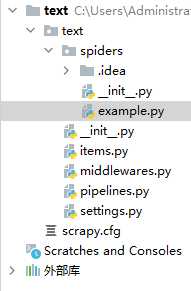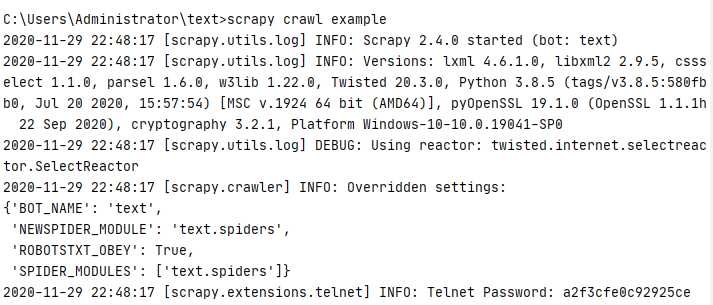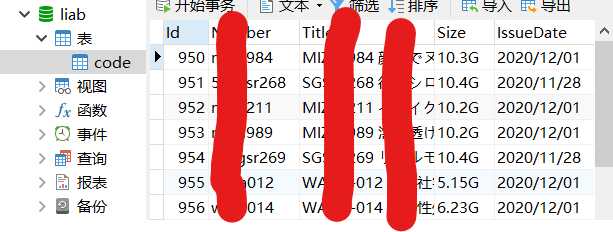1、检查我们的scrapy版本。截至2020年11月29日,scrapy的版本为2.4.0,方法是在cmd命令行中 scrapy version
如果你也与我一样,使用这个版本,那么可以确定,你可以复现我的这篇教程。
2、创建项目。在cmd中scrapy startproject text
这里我使用了text这个名字,如果你喜欢别的,也可以改成别的任何名字。如果你是新手,那么建议你还是像我一样照做,不然会在后面的代码里混淆掉。
2.1 创建一只爬虫。正如你在命令行中看到的提示那样,一般我们在创建完一个项目之后,马上就创建一只蜘蛛。
这时,我们已经完成了一只蜘蛛的创建,我们可以检查一下。使用pycharm打开这个项目,我们发现确实已经有一个example.py,这就是我们创建的蜘蛛的模块了。
这时,我们的准备工作算是完成了。
3、正式开始
3.1 定义我们需要的内容items.py
import scrapy
from scrapy.item import Item,Field
class TextItem(scrapy.Item):
# define the fields for your item here like:
# name = scrapy.Field()
title = Field() # 标题
number = Field() # 番号
issuedate = Field() # 发行时间
actress = Field() # 演员
type = Field() # 类型
magent = Field() # 磁力链接
size = Field() # 大小
image_urls = scrapy.Field() # 存储图片下载地址,必须是list列表形式,是下一步下载图片时图片的网页地址
image = scrapy.Field() # 存储图片下载地址及下载后的存储位置(相对路径)
imagepath = scrapy.Field() # 图片本地存储的位置
torrent_urls = scrapy.Field()
torrent = scrapy.Field()
torrent_magnet = scrapy.Field()
pass
3.2 编写蜘蛛。example.py
import scrapy
from text.items import TextItem # 此处如果报错是pyCharm的原因
from scrapy.http import Request
class ExampleSpider(scrapy.Spider):
name = 'example'
allowed_domains = ['bbs.xxxxxxxx.site']#抱歉这里是某网站的域名
start_urls = [
'https://xxxxxxxxxx',#抱歉这里是某网站的地址:)
]
def parse(self, response):
book_urls = response.xpath('//td/a[@class="subject"]/@href').extract()
for book_url in book_urls:
book_url ="https://bbs.ojxqsc.site/2048/" + book_url
yield Request(book_url, callback=self.parse_read)
def parse_read(self, response):
title = str(response.xpath('//td[@class="tal h"]/text()').extract_first()).replace("\n主题 : 【新片原档首发】 ","")
title = title.replace("\n","")
title = title.replace("主题 : ","")
title = title.replace("/", "")
if (str(response.xpath('//div[@class="f14"]/text()').extract()).find('品番: ') >= 0):
number = str(response.xpath('//div[@class="f14"]/text()').extract()).split('品番: ')[1].split("'")[0]
else:
number = 'null'
if (str(response.xpath('//div[@class="f14"]/text()').extract()).find('影片容量:') >= 0):
size =str(response.xpath('//div[@class="f14"]/text()').extract()).split('影片容量:')[1].split("'")[0]
else:
size ='null'
if (str(response.xpath('//div[@class="f14"]/text()').extract()).find('発売日: ') >= 0):
issuedate=str(response.xpath('//div[@class="f14"]/text()').extract()).split('発売日: ')[1].split("'")[0]
else:
issuedate='null'
if (str(response.xpath('//div[@class="f14"]/text()').extract()).find('出演者: ')>=0):
actress=str(response.xpath('//div[@class="f14"]/text()').extract()).split('出演者: ')[1].split("'")[0]
else:
actress = 'null'
if(str(response.xpath('//*[@id="read_tpc"]/img/@src').extract_first())!="None"):
print("筛选图片地址:"+str(response.xpath('//*[@id="read_tpc"]/img/@src').extract_first()))
image = response.xpath('//*[@id="read_tpc"]/img/@src').extract_first()
else:
image = response.xpath('//*[@id="read_tpc"]/a[1]/img/@src').extract_first() # 图片地址
torrent_urls = response.xpath('//*[@id="read_tpc"]/a/@href').extract()
for torrent_url in torrent_urls:
print("所有的网址是:"+str(torrent_url))
if("download" in str(torrent_url)):
print("现在的网址是:" +str(torrent_url))
yield Request(torrent_url, meta = {'image_urls':[image],'title':title,'number':number,'size':size,'issuedate':issuedate,'actress':actress},callback=self.parse_magnet, dont_filter=True)
else:
print("oh no!")
def parse_magnet(self, response):
torrent_magnet = response.xpath('//*[@class="uk-button "]/@href').extract_first() # 图片地址
print("现在的种子的内容是:" + str(torrent_magnet))
item = TextItem()
item['image_urls'] = response.meta['image_urls']
item['title'] = response.meta['title']
item['number']=response.meta['number']
item['size'] = response.meta['size']
item['issuedate'] = response.meta['issuedate']
item['actress'] = response.meta['actress']
print("图片地址:" + str(item['image_urls']))
print("文件路径:" + str(item['title']))
imagepath = str(response.meta['title'])
item['imagepath'] = "G:\GOO\\"+ imagepath+".jpg"
item['torrent_magnet'] = str(torrent_magnet)
yield item
3.3 编写管道 pipelines.py
from scrapy.pipelines.images import ImagesPipeline
from scrapy.http import Request
import pymysql.cursors
class TextPipeline(ImagesPipeline):
def get_media_requests(self, item, info):
for image_url in item['image_urls']:
yield Request(image_url, meta={'mid_item': item['title']})
def file_path(self, request, response=None, info=None):
title = request.meta['mid_item']+".jpg"
print("现在的标题是:"+title)
return title
class MySQLPipeline(object):
def __init__(self):
# 连接数据库
self.connect = pymysql.connect(
host='127.0.0.1', # 数据库地址
port=3306, # 数据库端口
db='liab', # 数据库名
user='root', # 数据库用户名
passwd='123456', # 数据库密码
charset='utf8', # 编码方式
use_unicode=True)
# 通过cursor执行增删查改
self.cursor = self.connect.cursor()
def process_item(self, item, spider):
self.cursor.execute(
"""insert into code(title,number,size,issuedate,actress,imageurl,torrentmagnet)
value (%s,%s,%s,%s,%s,%s,%s)""", # 纯属python操作mysql知识,不熟悉请恶补
(item['title'],
item['number'],
item['size'],
item['issuedate'],
item['actress'],
item['imagepath'],# item里面定义的字段和表字段对应
item['torrent_magnet'], # item里面定义的字段和表字段对应
))
# 提交sql语句
self.connect.commit()
return item # 必须实现返回
3.4 编写设置 setting.py
BOT_NAME = 'text'
SPIDER_MODULES = ['text.spiders']
NEWSPIDER_MODULE = 'text.spiders'
HTTPERROR_ALLOWED_CODES = [403]
HTTPERROR_ALLOWED_CODES = [404]
ROBOTSTXT_OBEY = True
ITEM_PIPELINES = {
'text.pipelines.TextPipeline': 1,
'text.pipelines.MySQLPipeline': 300,
}到这里,我们的项目就结束了。简单说一下它的功能。第一是将封面下载到本地。第二是将其他字段保存在本地的数据库中,封面图片在数据库中的保持方式为图片的地址,而不是图片的数据流。
4、让我们测试一下!
4.1 项目的启动。我们可以在pycharm中的terminal窗口键入scrapy crawl example
也可以在cmd窗口中使用相同的方法启动。
4.2 你可以在你的保存目录中找到这些图片。并且,你也可以在数据库中找到这些数据。
如果有什么地方不懂,欢迎留言或私信!
版权声明:本文内容由互联网用户自发贡献,该文观点仅代表作者本人。本站仅提供信息存储空间服务,不拥有所有权,不承担相关法律责任。如发现本站有涉嫌侵权/违法违规的内容, 请发送邮件至 举报,一经查实,本站将立刻删除。
如需转载请保留出处:https://bianchenghao.cn/36247.html






